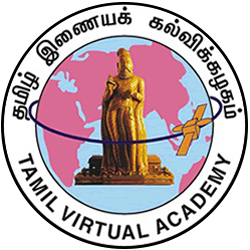Primary tabs
-
d03143 Lesson 3 Porulani Iyal - III
This lesson talks about anigal 10 to 14 mentioned in the "Dandialangaaram". They are, "Ottu Ani", "Adisaya Ani", "Tharkkuripetra Ani", "Edhu Ani" and "Nutpa Ani". The lesson gives a definition of these figures of speech, lists their classifications and explains them with apt examples from literary texts mentioned in the "Dandialangaaram".
Suggestiveness is an important quality in literature. The "Ottu Ani" is often used by poets to express an idea through suggestion rather than direct statement. When a poet describes an object or expresses an idea without directly stating it, but through another object or idea similar to it, it is called "Ottu Ani". "Ottu Ani" is known by different names such as "Ullurai Uvamam", "Uvamap Poli", "Pirithu Mozhithal", "Nuvala Nuvirchi" and "Kurippu Navirchi". Ancient literary texts such as the "Thirukkural", the "Kambaramayanam" and the "Seevagasinthamani" show extensive use of this ani.
Exaggerated description of the qualities or attributes of an object is called "Adisaya Ani". It is also known as "Uyarvu Navirchi Ani". The Adisaya Ani is classified into 6 types.
When a poet overlooks the natural causes of an action and instead attributes the action to a cause he imagines, it is called "Tharkkurippetra Ani". The Tharkurrippetra Ani is one of the widely used figures of speech in Tamil literature. In Sangam literature, the "Sialpathigaram", the "Kambaramayam" and the "Periyapuraanam" show frequent use of this figure of speech.
"Edhu Ani" is a figure of speech wherein the poet vividly describes the causes of an action or the attributes of an object. The two types of Edhu Ani are "Kaaraga Edhu" and "Gnabaga Edhu".
"Nutpa Ani" is a figure of speech in which the subject infers a message that is implied and conveys his or her reply either through suggestion or action. There are 2 types of Nutpa Ani: "Kurippu Nutpam" and Thozhil Nutpam.


